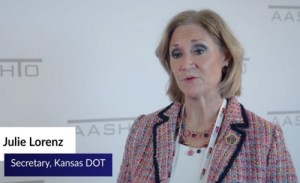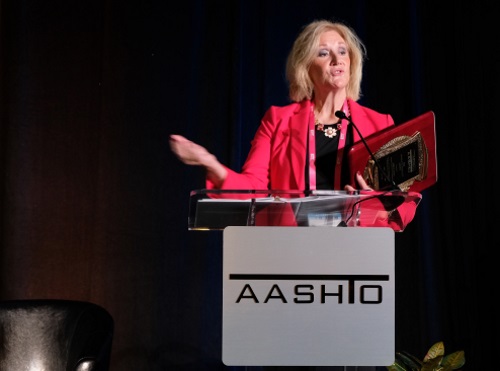An effort to draft a “cohesive national transportation vision” for the United States received approval to proceed during the American Association of State Highway and Transportation Officials 2022 Annual Meeting in Orlando.
[Above photo by AASHTO]
Julie Lorenz (seen above), secretary of the Kansas Department of Transportation, led the effort to create a national “framework” wherein state departments of transportation could work “collectively and individually” to develop an over-arching vision for addressing the country’s mobility needs of the future.

“We are coalescing around a vision focused on communities and people – about how we can drive down the cost of transportation, especially for the working poor,” she explained during a presentation at AASHTO’s 2022 Annual Meeting.
“It is all of us working together with our communities, urban and rural, as well as other state agencies and across state boundaries,” Lorenz noted. “The heart of the vision is community-centered transportation and making transportation work better for people.”

[Editor’s note: Lorenz received the George S. Bartlett Award at that meeting as well; an award given jointly by AASHTO, the American Road & Transportation Builders Association, and the Transportation Research Board in recognition of an individual who has made an outstanding contribution to highway progress.]
Lorenz – who described this effort as the “Moonshot Project,” in reference to the 1960s-era Apollo program that put American astronauts on the moon – said that establishing a “transportation vision” for America is but the first phase.
“It does us no good if we do not go to phase two and implement the vision we develop,” she stressed. “When we think about this ‘moonshot,’ we have to think about how we change the way we operate and maintain our transportation systems. To do that, we will need a range of strategies using different levers of change, both external and internal. For state DOTs, it will be about where they fit in across those various levers of change and identifying what works in your state.”
Lorenz also stressed that the creation of this “national transportation vision” is not mandated. Yet the reason state DOTs are taking on the role of creating it is because they are, in her words, the “fix it and get it done” departments across the country.
“This is all about our collective and individual actions towards the vision, with state DOTs able to set the context for what works for them in their particular regions,” Lorenz noted. “And AASHTO will develop tools and resources to help state DOTs to determine works well to advance the vision.”
 Nation
Nation
Registration Open for AASHTO’s Winter Rail Meeting
December 19, 2025 Nation
Nation

